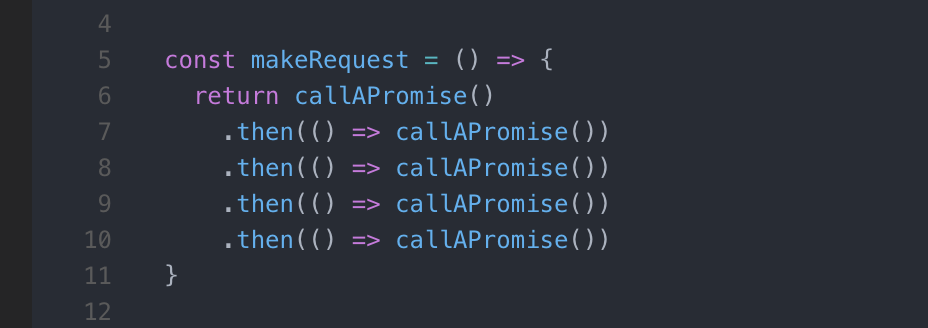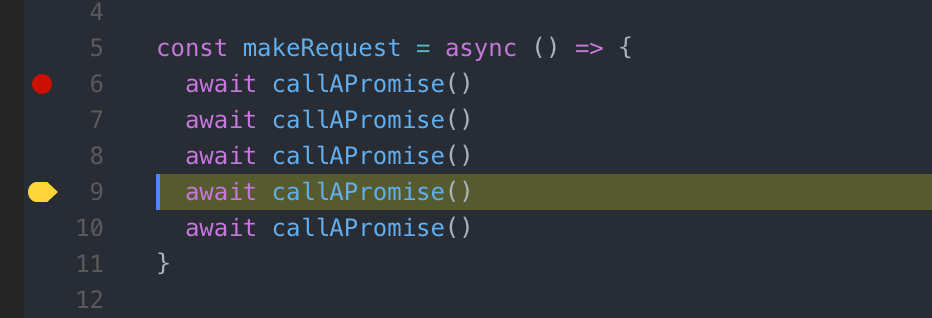【转】6 Reasons Why JavaScript’s Async/Await Blows Promises Away (Tutorial)
----------------------------------------------------------------------------------------------
6 Reasons Why JavaScript’s Async/Await Blows Promises Away (Tutorial)
In case you missed it, Node now supports async/await out of the box since version 7.6. If you haven’t tried it yet, here are a bunch of reasons with examples why you should adopt it immediately and never look back.
[UPDATE]: Node 8 LTS is out now with full Async/Await support.
[EDIT]: It seems that the embedded code on gist does not work on medium native app, but it works on mobile browsers. If you are reading this on the app, tap on the share icon and choose “open in browser” in order to see code snippets.
Async/await 101
For those who have never heard of this topic before, here’s a quick intro
- Async/await is a new way to write asynchronous code. Previous options for asynchronous code are callbacks and promises.
- Async/await is actually built on top of promises. It cannot be used with plain callbacks or node callbacks.
- Async/await is, like promises, non blocking.
- Async/await makes asynchronous code look and behave a little more like synchronous code. This is where all its power lies.
Syntax
Assuming a function getJSON that returns a promise, and that promise resolves with some JSON object. We just want to call it and log that JSON, then return "done".
This is how you would implement it using promises
const makeRequest = () =>
getJSON()
.then(data => {
console.log(data)
return "done"
}) makeRequest()
And this is how it looks with async/await
const makeRequest = async () => {
console.log(await getJSON())
return "done"
}
makeRequest()
There are a few differences here
- Our function has the keyword
asyncbefore it. Theawaitkeyword can only be used inside functions defined withasync. Anyasyncfunction returns a promise implicitly, and the resolve value of the promise will be whatever youreturnfrom the function (which is the string"done"in our case). - The above point implies that we can’t use await in the top level of our code since that is not inside an
asyncfunction.
3. await getJSON() means that the console.log call will wait until getJSON() promise resolves and print it value.
Why Is It better?
1. Concise and clean
Look at how much code we didn’t write! Even in the contrived example above, it’s clear we saved a decent amount of code. We didn’t have to write .then, create an anonymous function to handle the response, or give a name data to a variable that we don’t need to use. We also avoided nesting our code. These small advantages add up quickly, which will become more obvious in the following code examples.
2. Error handling
Async/await makes it finally possible to handle both synchronous and asynchronous errors with the same construct, good old try/catch. In the example below with promises, the try/catch will not handle if JSON.parsefails because it’s happening inside a promise. We need to call .catch on the promise and duplicate our error handling code, which will (hopefully) be more sophisticated than console.log in your production ready code.
Now look at the same code with async/await. The catch block now will handle parsing errors.
3. Conditionals
Imagine something like the code below which fetches some data and decides whether it should return that or get more details based on some value in the data.
Just looking at this gives you a headache. It’s easy to get lost in all that nesting (6 levels), braces, and return statements that are only needed to propagate the final result up to the main promise.
This example becomes way more readable when rewritten with async/await.
4. Intermediate values
You have probably found yourself in a situation where you call a promise1and then use what it returns to call promise2, then use the results of both promises to call a promise3. Your code most likely looked like this
If promise3 didn’t require value1 it would be easy to flatten the promise nesting a bit. If you are the kind of person who couldn’t live with this, you could wrap both values 1 & 2 in a Promise.all and avoid deeper nesting, like this
This approach sacrifices semantics for the sake of readability. There is no reason for value1 & value2 to belong in an array together, except to avoid nesting promises.
This same logic becomes ridiculously simple and intuitive with async/await. It makes you wonder about all the things you could have done in the time that you spent struggling to make promises look less hideous.
5. Error stacks
Imagine a piece of code that calls multiple promises in a chain, and somewhere down the chain an error is thrown.
The error stack returned from a promise chain gives no clue of where the error happened. Even worse, it’s misleading; the only function name it contains is callAPromise which is totally innocent of this error (the file and line number are still useful though).
However, the error stack from async/await points to the function that contains the error
This is not a huge plus when you’re developing on your local environment and have the file open in an editor, but it’s quite useful when you’re trying to make sense of error logs coming from your production server. In such cases, knowing the error happened in makeRequest is better than knowing that the error came from a then after a then after a then …
6. Debugging
Last but not least, a killer advantage when using async/await is that it’s much easier to debug. Debugging promises has always been such a pain for 2 reasons
- You can’t set breakpoints in arrow functions that return expressions (no body).

Try setting a breakpoint anywhere here
2. If you set a breakpoint inside a .then block and use debug shortcuts like step-over, the debugger will not move to the the following .then because it only “steps” through synchronous code.
With async/await you don’t need arrow functions as much, and you can step through await calls exactly as if they were normal synchronous calls.

In Conclusion
Async/await is one of the most revolutionary features that have been added to JavaScript in the past few years. It makes you realize what a syntactical mess promises are, and provides an intuitive replacement.
Concerns
Some valid skepticism you might have about using this feature
- It makes asynchronous code less obvious: Our eyes learned to spot asynchronous code whenever we see a callback or a
.then, it will take a few weeks for your eyes to adjust to the new signs, but C# had this feature for years and people who are familiar with it know it’s worth this minor, temporary inconvenience. - Node 7 is not an LTS release: Yes, but node 8 is coming next month, and migrating you codebase to the new version will most likely take little to no effort. [UPDATE]: Node 8 LTS is now out.
【转】6 Reasons Why JavaScript’s Async/Await Blows Promises Away (Tutorial)的更多相关文章
- [转] 理解 JavaScript 的 async/await
[From] https://segmentfault.com/a/1190000007535316 边城 2016年11月19日发布 随着 Node 7 的发布,越来越多的人开始研究据说是 ...
- 【前端_js】理解 JavaScript 的 async/await
async 和 await 在干什么 任意一个名称都是有意义的,先从字面意思来理解.async 是“异步”的简写,而 await 可以认为是 async wait 的简写.所以应该很好理解 async ...
- 理解 JavaScript 的 async/await
随着 Node 7 的发布,越来越多的人开始研究据说是异步编程终级解决方案的 async/await.我第一次看到这组关键字并不是在 JavaScript 语言里,而是在 c# 5.0 的语法中.C# ...
- [转] Understanding JavaScript’s async await
PS:Promise的用处是异步调用,这个对象使用的时候,call then函数,传一个处理函数进去,处理异步调用后的结果 Promise<Action>这样的对象呢,异步调用后的结果是一 ...
- JavaScript 的 Async\/Await 完胜 Promise 的六
参考:http://www.10tiao.com/html/558/201705/2650964601/1.html Node 现在从版本 7.6 开始就支持 async/await 了. 简介: A ...
- 深入理解理解 JavaScript 的 async/await
原文地址:https://segmentfault.com/a/1190000007535316,首先感谢原文作者对该知识的总结与分享.本文是在自己理解的基础上略作修改所写,主要为了加深对该知识点的理 ...
- JavaScript 的 async/await
随着 Node 7 的发布,越来越多的人开始研究据说是异步编程终级解决方案的 async/await. 异步编程的最高境界,就是根本不用关心它是不是异步. async 函数就是隧道尽头的亮光,很多人认 ...
- JavaScript 利用 async await 实现 sleep 效果
const sleep = (timeountMS) => new Promise((resolve) => { setTimeout(resolve, timeountMS); }); ...
- Async/Await替代Promise的6个理由
译者按: Node.js的异步编程方式有效提高了应用性能:然而回调地狱却让人望而生畏,Promise让我们告别回调函数,写出更优雅的异步代码:在实践过程中,却发现Promise并不完美:技术进步是无止 ...
随机推荐
- TCP/IP重新学习
TCP/IP 是用于因特网 (Internet) 的通信协议. 1.什么是TCP/IP? TCP/IP 是供已连接因特网的计算机进行通信的通信协议. TCP/IP 指传输控制协议/网际协议(Trans ...
- HDU 6024 Building Shops
$dp$. $dp[i]$表示到$i$位置,且$i$位置建立了的最小花费,那么$dp[i] = min(dp[k]+cost[i+1][k-1])$,$k$是上一个建的位置.最后枚举$dp[i]$,加 ...
- 洛谷P2286 [HNOI2004]宠物收养所 [STL,平衡树]
题目传送门 宠物收养所 题目描述 凡凡开了一间宠物收养场.收养场提供两种服务:收养被主人遗弃的宠物和让新的主人领养这些宠物. 每个领养者都希望领养到自己满意的宠物,凡凡根据领养者的要求通过他自己发明的 ...
- 对java前后端分离的理解
到目前为止,身为一个java后端开发人员的我, 在工作期间,无非就是ui设计页面,前端开发html,之后将做好的页面交给我,我负责后台逻辑一件html的页面渲染. 好好滴一个后台开发人员,莫名其妙的做 ...
- 【BZOJ 3443】 3443: 装备合成 (离线+线段树)
3443: 装备合成 Time Limit: 15 Sec Memory Limit: 128 MBSubmit: 63 Solved: 31 Description [背景] lll69 ...
- 各种背包的dp刷题板
[p1332][NYOJ skiing] 滑雪 (dp+搜索) [p1312] [vjios1448 路灯改建计划] 关灯问题 (背包预处理的分组背包) f[i][j]表示给把前i个灯分为j组可以获 ...
- bzoj1977 次小生成树
Description 小 C 最近学了很多最小生成树的算法,Prim 算法.Kurskal 算法.消圈算法等等. 正当小 C 洋洋得意之时,小 P 又来泼小 C 冷水了.小 P 说,让小 C 求出一 ...
- ngxin error日志
日志模块ngx_errlog_module对于支持可变参数平台提供的三个接口 #define ngx_log_error(level, log, ...) \ if ((log)->log_le ...
- php uncode 转汉字编码
$test = "%u4E0A%u6D77%u9EC4%u6D66";//$test = '\u5e86\u91cd\u5e86'; //庆重庆$temp = explode('% ...
- 51nod 1225 余数之和 数论
1225 余数之和 题目连接: http://www.51nod.com/onlineJudge/questionCode.html#!problemId=1225 Description F(n) ...
